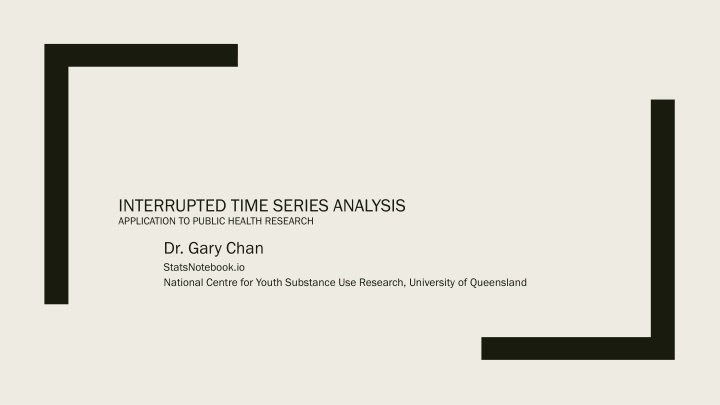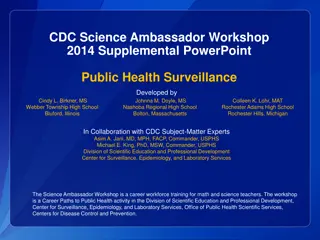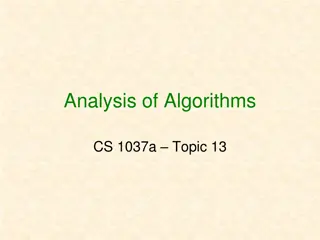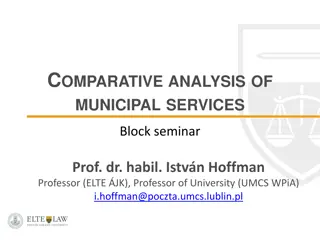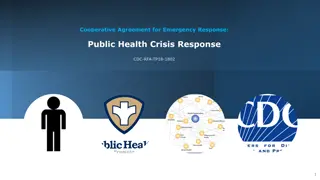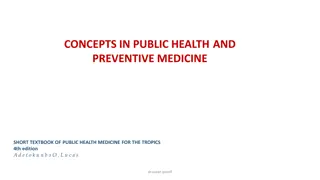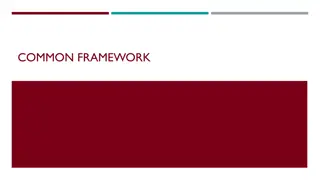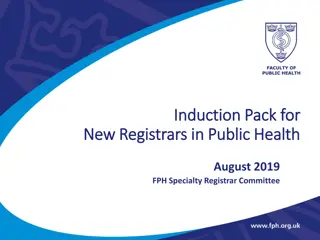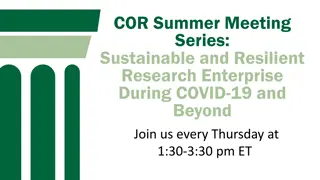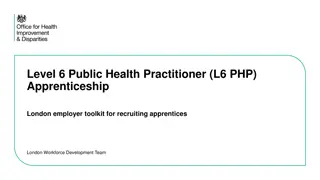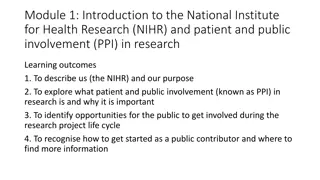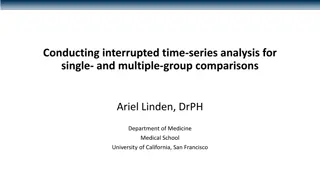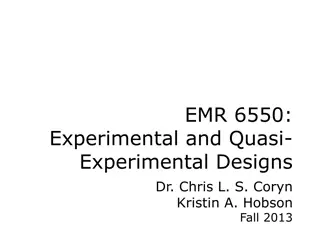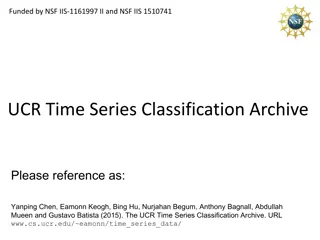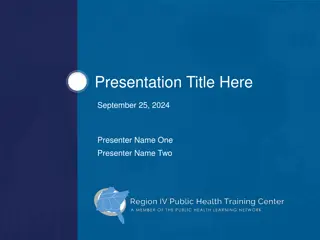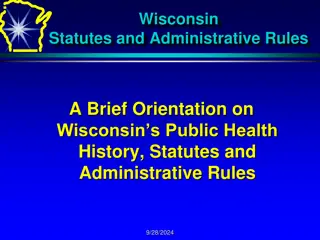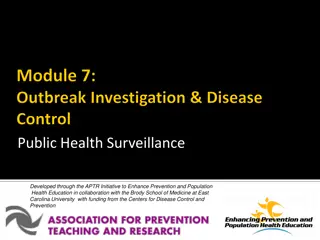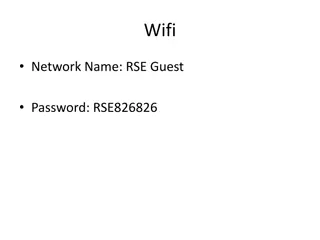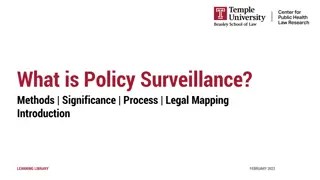Application of Interrupted Time Series Analysis in Public Health Research
In public health research, Interrupted Time Series Analysis (ITS) is a powerful method used to evaluate the impact of interventions, such as the effect of minimum pricing policy on alcohol consumption. By analyzing time-series data before and after the intervention, researchers can assess changes in the outcome while accounting for underlying trends. Nave analysis may overlook critical trends, making ITS a more robust approach for assessing policy effectiveness in public health. Key references and a motivating example of alcohol consumption reduction in the Northern Territory are provided.
Download Presentation

Please find below an Image/Link to download the presentation.
The content on the website is provided AS IS for your information and personal use only. It may not be sold, licensed, or shared on other websites without obtaining consent from the author.If you encounter any issues during the download, it is possible that the publisher has removed the file from their server.
You are allowed to download the files provided on this website for personal or commercial use, subject to the condition that they are used lawfully. All files are the property of their respective owners.
The content on the website is provided AS IS for your information and personal use only. It may not be sold, licensed, or shared on other websites without obtaining consent from the author.
E N D
Presentation Transcript
INTERRUPTED TIME SERIES ANALYSIS APPLICATION TO PUBLIC HEALTH RESEARCH Dr. Gary Chan StatsNotebook.io National Centre for Youth Substance Use Research, University of Queensland
References Bernal, J. L., Cummins, S., & Gasparrini, A. (2017). Interrupted time series regression for the evaluation of public health interventions: a tutorial. International journal of epidemiology, 46(1), 348-355. Bhaskaran, K., Gasparrini, A., Hajat, S., Smeeth, L., & Armstrong, B. (2013). Time series regression studies in environmental epidemiology. International journal of epidemiology, 42(4), 1187-1195. Bottomley, C., Scott, J. A. G., & Isham, V. (2019). Analysing interrupted time series with a control. Epidemiologic methods, 8(1). Hemming, K., Haines, T. P., Chilton, P. J., Girling, A. J., & Lilford, R. J. (2015). The stepped wedge cluster randomised trial: rationale, design, analysis, and reporting. BMJ, 350. Linden, A. (2015). Conducting interrupted time-series analysis for single-and multiple-group comparisons. The Stata Journal, 15(2), 480-500. Linden, A. (2018). Combining synthetic controls and interrupted time series analysis to improve causal inference in program evaluation. Journal of evaluation in clinical practice, 24(2), 447-453. Lopez Bernal, J., Cummins, S., & Gasparrini, A. (2018). The use of controls in interrupted time series studies of public health interventions. International journal of epidemiology, 47(6), 2082-2093. Turner, S. L., Karahalios, A., Forbes, A. B., Taljaard, M., Grimshaw, J. M., Cheng, A. C., . . . McKenzie, J. E. (2020). Design characteristics and statistical methods used in interrupted time series studies evaluating public health interventions: a review. Journal of clinical epidemiology, 122, 1-11.
Motivating Example To reduce alcohol consumption in Northern Territory, the government implemented a minimum price for alcohol in 2018. Does this policy work? (i.e. reducing alcohol consumption in the population?)
Nave analysis Compared average/median population alcohol consumption before and after.
Nave analysis Compared average population alcohol consumption before and after. Ignore the underlying trend If there is an existing downward trend, population alcohol at post-intervention period will be lower regardless if minimum pricing has any impact
Interrupted time series analysis (ITS) Evaluate policy impact on an outcome (e.g. population alcohol consumption) over a clearly defined time period (e.g. 2 year before and 2 year after the implementation of minimum pricing policy) A time series of the outcome (population alcohol consumption) is used to established an underlying trend We then test of such trend is interrupted by an intervention at a known time point (the day on which the minimum pricing policy was implemented)
Interrupted time series analysis (ITS) ITS is compatible with the causal inference framework Can be conceptualized as comparing the observed post-intervention data to the expected trend, i.e. what would have been observed if there were no intervention The expected trend is never observed thus it is a counterfactual scenario.
Interrupted time series analysis (ITS) ITS is compatible with the causal inference framework Can be conceptualized as comparing the observed post-intervention data to the expected trend, i.e. what would have been observed if there were no intervention The expected trend is never observed thus it is a counterfactual scenario.
ITS study design Requires a clear differentiation of the pre-intervention and post-intervention period. Outcome measures that changes relatively quickly after the intervention are suitable Alcohol consumption (suitable) Incident of liver cirrhosis (NOT suitable)
ITS study design No fixed limits on the number of data point Power depends on Distribution of the data Variability within the data Aggregated population data usually have relatively small variability Strength of the effect Strong intervention effect = strong power
ITS study design More data =/= better If historical trend changed substantially, it would not give an accurate estimation of the current underlying trend Inspect pre-intervention data visually before any formal analysis
ITS study design Specify the model a-priori How will the intervention impact on the outcome? Is immediate change expected? Is an interruption of the underlying trend expected? Figure from Bernal, et al (2017)
Regression model for ITS Three variables are needed (minimum) T: A variable indicating time (e.g. from the beginning of the study). Xt: A variable indicating the pre-intervention (dummied coded as 0) and post- intervention period (dummied coded as 1) Yt: The outcome variable at time t. Regression model ??= ?0+ ?1? + ?2??+ ?3??? ?0:????????? ??????? ??????? ?? ? = 0 ?1:????? ????? ?????? ? ? ???????????? ?2:????????? ? ???? ? ?? ? ? ???????????? ?? ??????????? ?3:? ???? ?? ????? ????? ? ? ????????????
Regression model for ITS Regression model ??= ?0+ ?1? + ?2??+ ?3??? ?0:????????? ??????? ??????? ?? ? = 0 ?1:????? ????? ?????? ? ? ???????????? ?2:????????? ? ???? ? ?? ? ? ???????????? ?? ??????????? ?3:? ???? ?? ????? ????? ? ? ????????????
Regression model for ITS Seasonality When there is an obvious seasonality pattern in the outcome (e.g. incident of flu), it is important to account for seasonality If the pre- or post- intervention has more data from the winter months, the results would be biased. Add a variable representing seasons Spring, Summer, Autumn and Winter Use more complex functions (combination of sine and cosine).
Regression model for ITS Autocorrelation Observations tend to be more similar in closer time that those further apart. Violated the assumption of standard regression In public health research, autocorrelation is generally largely explained by other variables such as seasonality. Autocorrelation is rarely a big issue in public health research. Plot the Autocorrelation function (ACF) or the Partial autocorrelation function (PACF) Accounting for autocorrelation specifically by specifying the error (residual) structure.
Motivating Example To reduce alcohol consumption in Northern Territory, the government implemented a minimum price for alcohol in 2018. Does this policy work? (i.e. reducing alcohol consumption in the population?)
Motivating Example R/RStudio/StatsNotebook Libraries required tidyverse ggplot2 tsModel nlme emmeans
Motivating Example Simulated dataset https://statsnotebook.io/blog/data_management/example_data/alcohol_data_NT.csv
Motivating Example Plotting the data
Motivating Example Running the preliminary model
Motivating Example Plotting the autocorrelation function and the partial autocorrelation function
Motivating Example Plotting model-based prediction
Motivating Example Rerun the model adjusting for autocorrelation
Motivating Example Rerun the model adjusting for seasonality using the harmonic() from the tsModel library Two parameters: Number of sine/cosine pair to use and the length of one cycle
Interrupted time series analysis (ITS) Follow a single population over time => free from problems due to between group differences such as selection bias and unmeasured confounding Controls for within-group characteristics. Major threat to causal inference Time-varying confounding E.g. National Campaign on reducing alcohol use around the same period. Inclusion of a control can address this issue
ITS with controls Stronger design Evaluate intervention within (pre/post comparison) and between groups Absence of any intervention effect in the control provide stronger evidence Compare the time series data from Northern Territory with those from other states (e.g. Queensland) If there is an interruption in alcohol use Northern Territory and there is no such interruption in Queensland, we can confidently conclude that the minimum pricing policy reduced alcohol consumption in the Northern Territory population.
Regression model for ITS with controls Four variables are needed. T: A variable indicating time. Xt: A variable indicating the pre-intervention (dummied coded as 0) and post- intervention period (dummied coded as 1) Z: A variable indicating whether it is the control series (dummied coded as 0) or the intervention series (dummied coded as 1) Yt: The outcome variable at time t. Regression model ??= ?0+ ?1? + ?2??+ ?3???+ ?4? + ?5???+ ?6???+ ?7????
Regression model for ITS with controls Regression model ??= ?0+ ?1? + ?2??+ ?3???+ ?4? + ?5???+ ?6???+ ?7???? ?0:????????? ??????? ?? ? ? ??????? ?????? ?? ? = 0 ?1:????? ?????? ? ? ???????????? ?? ? ? ??????? ?????? ?2:????????? ? ???? ?? ? ? ??????? ?????? ????? ? ? ???????????? ?3:? ???? ?? ????? ????? ? ? ???????????? ?? ? ? ??????? ?????? ?4:?????????? ?? ????????? ??????? ? ? ??????? ??? ???????????? ?????? ?5:?????????? ?? ? ? ??????????????? ????? ??????? ? ? ??????? ??? ???????????? ?????? ?6:?????????? ?? ? ? ????????? ? ???? ??????? ? ? ??????? ??? ? ? ???????????? ?????? ????? ? ? ???????????? ?7:?????????? ?? ? ? ? ???? ?? ????? ????? ? ? ???????????? ??????? ? ? ??????? ??? ? ? ???????????? ??????
Motivating Example To reduce alcohol consumption in Northern Territory, the government implemented a minimum price for alcohol in 2018. Does this policy work? (i.e. reducing alcohol consumption in the population?) Compare the population alcohol consumption trends before and after minimum pricing policy in Northern Territory (i.e. within the state) Compare if the pre/post implementation trend in Northern Territory against Western Australia (across states)
StatsNotebook Graphical interface for R
Other considerations Which if my variable is a count variable or a rate Number of emergency presentation relating to alcohol use (count) Number of alcohol-related domestic violence incidents per 100000 population (rate) Count variable with a Poisson distribution can be approximate by normal distribution when the mean of the Poisson distribution is large enough. How large is large?
Poisson regression Poisson regression can be used to model count variable. The glm() function can be used. In the presence of autocorrelation, the standard error will need to be adjusted. The NeweyWest() function from the package sandwich is needed.
